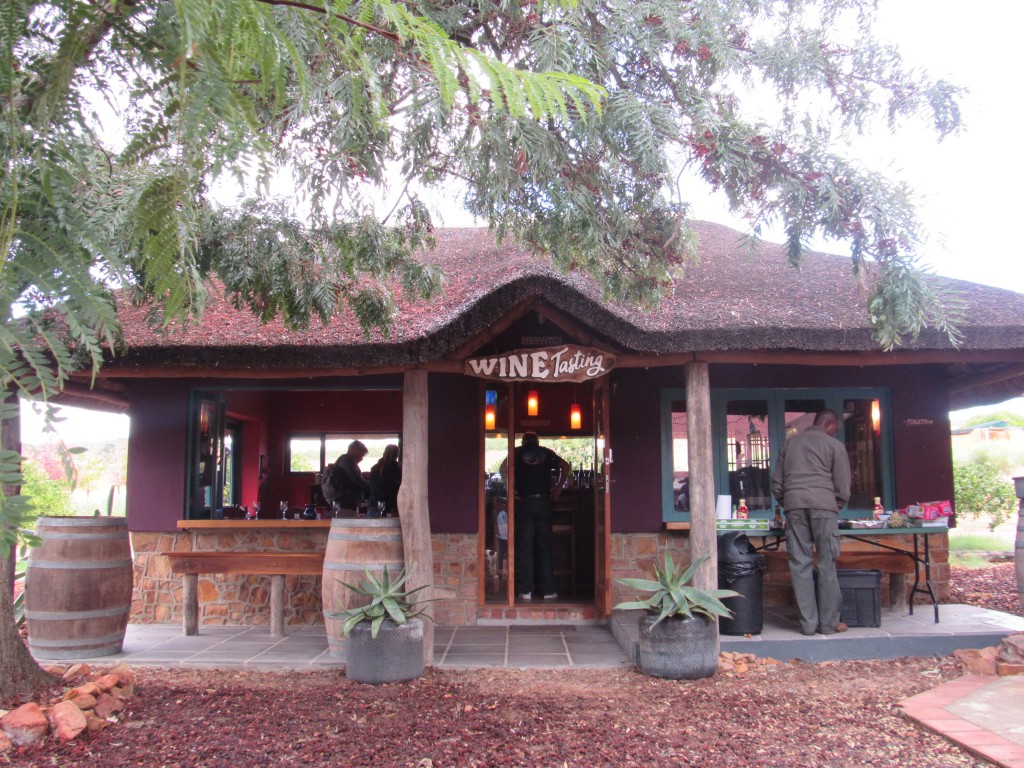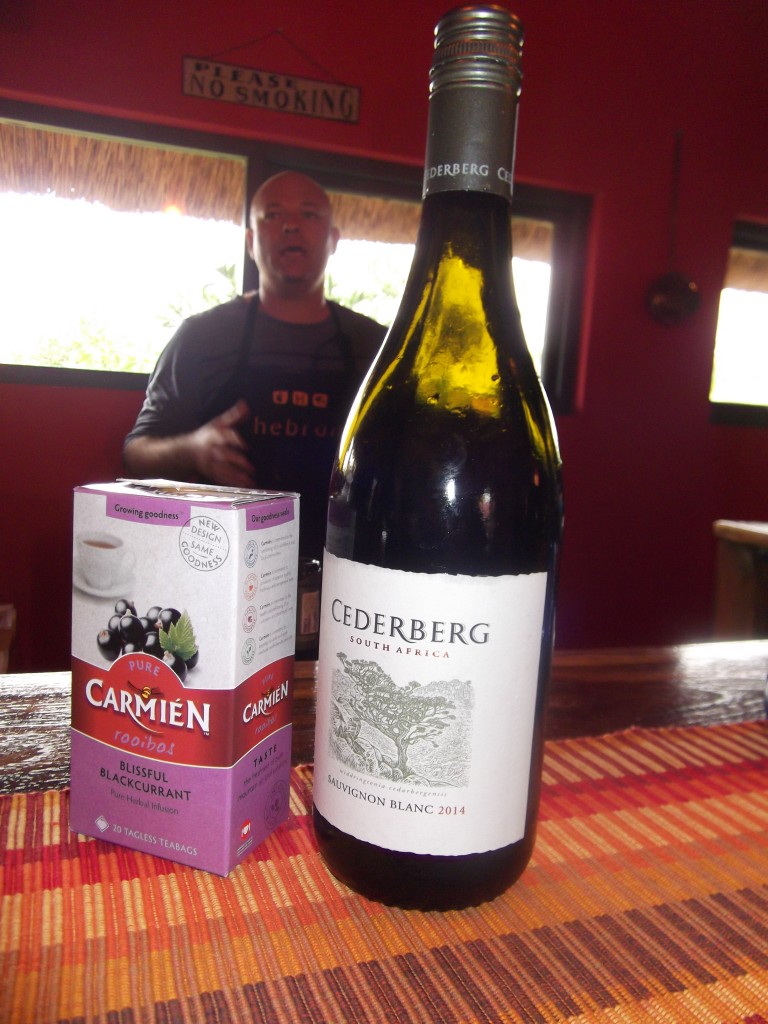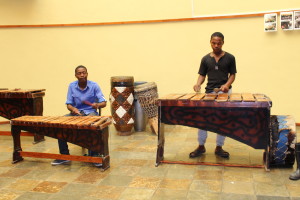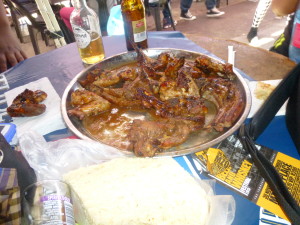The post African Overland Adventure: Cape Town to Namibia first appeared on The Travel Sista.
]]>Day 1 – South Africa, Cedarberg Region
As instructed, I arrived at the Nomads Cape Town office at 7:30 a.m. with one soft duffle bag and a backpack (we’d been instructed not to bring roller bags or large pieces of luggage because they could not fit on the truck). After checking in, we boarded the large truck, secured our bags in the on-board lockers, and met our guide, Gift, and driver, Alfons. After a quick de-briefing and group introductions, we left around 8:30 a.m. and headed to Table View, a Cape Town suburb named for its view of Table Mountain from across Table Bay. Unfortunately for us, a thick fog partially obscured the beautiful view and dashed our dreams of capturing the perfect photo. By early afternoon, we arrived in Citrusdal, a small village in the Cedarberg region known for its abundance of citrus orchards and rooibos plants which are endemic to the area. There we stopped at Hebron — a working farm, restaurant, guesthouse and farmstall — for lunch and tastings of locally-produced rooibos tea and wine. We tasted two flavored rooibos teas, vanilla and black currant, and three wines, Chardonnay, Sauvignon Blanc, and Merlot, all of which were tasty. After the tasting we checked into our hotel and relaxed for several hours before heading back to Hebron for a private dinner. The owner, Chef Steve, cooked a succulent meal of steak, mashed potatoes and gravy, and sautéed spinach, which was accompanied by a local Chardonnay we purchased during the earlier tasting. For dessert, he made a flourless cake with raspberry sauce, which was also delicious. It was the perfect ending to a wonderful day and the perfect start to a fantastic week.
Day 2 – Namibia, Gariep (Orange) River
We woke up early the next morning, and after a tasty buffet breakfast at the hotel, we hit the road headed north towards the Namaqualand region in the Northern Cape of South Africa. About four hours later, we arrived in Springbok, the capital of Namaqualand. Though we wouldn’t see it, Namaqualand is best known for the annual spring phenomenon (July to September) when millions of wild flowers bloom to life transforming the normally dry landscape into an explosion of color. After a quick bit of shopping, sightseeing and lunch, we returned to the road, finally arriving at the South Africa-Namibia border about two hours later. We entered Namibia at the Noordoewer/Vioolsdrif border crossing and proceeded on about 15 minutes later after getting our passports stamped. We were pleasantly surprised when we arrived at our nearby lodging, Felix Unite Camp, located on the banks of the Orange River. Our thatched huts had private patios and stunning mountain and river views. While some of the group went hiking or swimming, I spent the rest of the day sitting on my patio, drinking wine and taking it all in. The setting was just magical.
Stay tuned for Days 3 and 4
**This tour was booked by Detour Africa, which graciously offered a discount for my review. All descriptions and opinions are my own. Detour Africa offers a variety of private and group tours and safaris, catering to any budget, large or small.
Share ThisThe post African Overland Adventure: Cape Town to Namibia first appeared on The Travel Sista.
]]>The post Robben Island first appeared on The Travel Sista.
]]> Nelson Mandela is one of my personal heroes. So needless to say, my trip to Cape Town had to include a visit to Robben Island, where he was imprisoned for nearly 20 years for fighting against apartheid. Little did I know just how significant and special my visit would be; I went about one month before his death in December 2013.
Nelson Mandela is one of my personal heroes. So needless to say, my trip to Cape Town had to include a visit to Robben Island, where he was imprisoned for nearly 20 years for fighting against apartheid. Little did I know just how significant and special my visit would be; I went about one month before his death in December 2013.
After a 30-minute ferry ride, we arrived on the island and were escorted to waiting buses for a narrated tour. The bus drove us around the large island, while our tour guide pointed out buildings and historical facts of significance. We saw the living quarters of professor Robert Sobukwe, an anti-apartheid activist who was kept in solitary confinement for almost 7 years, in an area separate from other political prisoners.

 We exited the bus to visit Section D, the maximum security prison where Mandela and other political prisoners were jailed; we even saw Mandela’s actual cell. This part of the tour was conducted by Kolekile Mahlahla, a former political prisoner who shared harsh details about their daily life, and how even in prison race dictated their diets, activities, clothing, and sleeping arrangements. Whites, Coloureds, and Indians were given more food than Blacks. They were also allowed to wear long pants and shoes, unlike Blacks who could only wear shorts and no shoes. Whites slept on mattresses, while Blacks had burlap sacks.
We exited the bus to visit Section D, the maximum security prison where Mandela and other political prisoners were jailed; we even saw Mandela’s actual cell. This part of the tour was conducted by Kolekile Mahlahla, a former political prisoner who shared harsh details about their daily life, and how even in prison race dictated their diets, activities, clothing, and sleeping arrangements. Whites, Coloureds, and Indians were given more food than Blacks. They were also allowed to wear long pants and shoes, unlike Blacks who could only wear shorts and no shoes. Whites slept on mattresses, while Blacks had burlap sacks.
Mahlahla also shared stories about his interactions with Mandela and other older prisoners. He described how Mandela both earned the respect of some guards and acted as a leader to younger prisoners, promoting education and peaceful strategy over armed strife. This part of the tour was the most fascinating for me, because we were able to ask questions and get a true sense of being there during the apartheid era. 
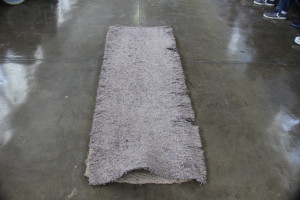
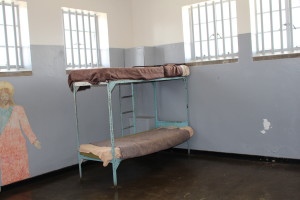
 Towards the end of the tour, we visited the limestone quarry where political prisoners were forced to work hard labor for 12+ hours per day. We learned the quarry became known as the “University” and was the site of secret classes and debates among the political prisoners. We also saw a rock pile left there by Mandela and other prisoners during a 1995 reunion, as a remembrance of their time on the island and a symbol of their solidarity. We ended the tour the same way we started –with a half hour ferry ride across the Atlantic Ocean, back to the city. The ride gave you a true sense of the isolation and human wasteland that place was intended to be. But far from that, Robben Island is a testimony to the resilience of the human spirit and the triumph of good over evil.
Towards the end of the tour, we visited the limestone quarry where political prisoners were forced to work hard labor for 12+ hours per day. We learned the quarry became known as the “University” and was the site of secret classes and debates among the political prisoners. We also saw a rock pile left there by Mandela and other prisoners during a 1995 reunion, as a remembrance of their time on the island and a symbol of their solidarity. We ended the tour the same way we started –with a half hour ferry ride across the Atlantic Ocean, back to the city. The ride gave you a true sense of the isolation and human wasteland that place was intended to be. But far from that, Robben Island is a testimony to the resilience of the human spirit and the triumph of good over evil.
The post Robben Island first appeared on The Travel Sista.
]]>The post My Top 10 Things to Do in Cape Town first appeared on The Travel Sista.
]]>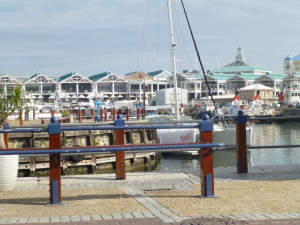 Cape Town is a beautiful, modern city with a diversity of people, landscapes, and activities. The New York Times recently named Cape Town as its top city to visit in 2014 and I certainly agree. Here’s my list of the top 10 things to do in Cape Town (not in any order of preference):
Cape Town is a beautiful, modern city with a diversity of people, landscapes, and activities. The New York Times recently named Cape Town as its top city to visit in 2014 and I certainly agree. Here’s my list of the top 10 things to do in Cape Town (not in any order of preference):
1. Table Mountain
Cape Town’s most famous landmark, this flat-topped mountain overlooks the city forming part of the City Bowl. Hike or ride the cable car to the top to see stunning views of the Cape Peninsula.
2. Cape Point and Cape of Good Hope
At the southern end of the Cape Peninsula are Cape Point and the Cape of Good Hope, which offer amazing views of the coast of the Atlantic Ocean. Although the Cape of Good Hope is popularly known as the meeting place of the Indian and Atlantic Oceans, that distinction really belongs to Cape Algulhas, approximately 120 miles to the southeast.
3. Camp’s Bay Beach and Boulders Beach/South African penguins
Cape Town has numerous amazing beaches, more than you’ll probably have time to visit. If you have to choose just a couple, you can’t go wrong with these two. Camp’s Bay is probably the most beautiful (though it’s also cold), with gorgeous white sand and amazing mountain views. It’s a great place to see a South African sunset (“sundowner” as they say).
Boulders Beach, named for the massive granite boulders that line the landscape, is home to Cape Town’s colony of endangered South African penguins. Its waters – on the Indian Ocean side of the Cape Peninsula – are warm, calm, and safe for swimming.
4. Robben Island
Robben Island is best known as the prison where Nelson Mandela was held for nearly 20 years for fighting against apartheid. Now it’s a popular tourist attraction, with daily tours departing from the Nelson Mandela Gateway at the V & A Waterfront. Tours often sell out weeks in advance, so it’s best to pre-book tickets. Arrive a little early to visit the Robben Island Museum before the tour.
5. V & A Waterfront
Set against a backdrop of beautiful sea and mountain views, the Victoria & Alfred Waterfront is one of Cape Town’s biggest tourist spots, with restaurants, specialty shops, craft markets, pubs, museums, movies and an aquarium. The Victoria Wharf shopping mall is also situated at the Waterfront.
6. African Dance Theater
This one-hour show takes you through the history of South African dance and music. The high energy performance is conducted by talented performers who obviously love what they do.
7. Green Market Square
Green Market Square is one of Cape town’s oldest markets (and arguably the best), full of beautiful art, crafts, jewelry, and clothing. This is the place to shop for souvenirs and other mementos. Be ready to haggle and deal for great prices.
8. District 6 Museum, District 6 and Bo Kaap
During the apartheid era, the non-white residents of District 6 were forcibly removed from their homes, which were bulldozed after District 6 was declared a whites-only area. The District 6 Museum tells the story of the district, the forced removals, and the community’s hopes to rebuild it; it includes photographs, handwritten notes, and other memorabilia from residents. Today, District 6 still stands largely vacant, though some former residents have recently returned to the area. It is a stark reminder of South Africa‘s past.
The nearby Bo Kaap is home to Cape Town’s Cape Malay people and culture. The streets are lined with bright-colored houses and there are several mosques in the area. The area is also known for its Cape Malay cuisine, which is a fusion of traditional South African and Malaysian flavors. Walking tours and culinary tours are available.
9. Township Tour
Black and Coloured South Africans were forced to move to segregated townships during apartheid. Today, the townships are still home to a majority of them. Although there is widespread poverty, there is also a vibrant community, diversity of cultures, and an amazing history of struggle and triumph. The best township tours are walking tours conducted by local residents. They not only infuse much needed tourist dollars into the community, but they give visitors an opportunity to interact with locals and get a firsthand view of the good and bad of post-apartheid township life. A township tour is sure to be an unforgettable experience.
10. Cape Winelands
Located just 30-45 minutes from the city center, the Cape Winelands are formed by a number of towns and suburbs in the Western Cape. Some of the more popular wine routes include Stellenbosch, Franschhoek, Paarl, and Constantia Valley. The beautiful scenery, affordable tastings, and delicious wines make for great day (or few days) of relaxation and indulgence. No visit to Cape Town is complete without experiencing the beauty of the Winelands.
For more ideas on things to do in Cape Town and around South Africa, check out Your Next Big Trip.
What is your favorite thing to do in Cape Town? Share your comments below.
Share ThisThe post My Top 10 Things to Do in Cape Town first appeared on The Travel Sista.
]]>The post Cape Winelands: Stellenbosch first appeared on The Travel Sista.
]]> Next, we moved on to the Peter Falke estate. We chose it because it stayed open until 7 pm, but later learned it has a reputation as the best sundowner (sunset) retreat in the winelands. The indoor tasting room was modern and classy, but it had nothing on the outdoors. The mountain backdrops are stunning and the huge decorative corkscrews add a quirky, fun appeal to the luxury outdoor lounge. We did a tasting of four wines, which were paired with a variety of olives (yummy!).
Next, we moved on to the Peter Falke estate. We chose it because it stayed open until 7 pm, but later learned it has a reputation as the best sundowner (sunset) retreat in the winelands. The indoor tasting room was modern and classy, but it had nothing on the outdoors. The mountain backdrops are stunning and the huge decorative corkscrews add a quirky, fun appeal to the luxury outdoor lounge. We did a tasting of four wines, which were paired with a variety of olives (yummy!).
 It was a relaxing afternoon as we soaked in our surroundings and enjoyed the beginnings of a beautiful South African sunset. We returned to the city before dark, feeling nice and with several souvenir bottles of wine in tow. I look forward to returning to the winelands one day, though I’d definitely plan at least 2 days in order to add Franschhoek, South Africa’s Gourmet Capital.
It was a relaxing afternoon as we soaked in our surroundings and enjoyed the beginnings of a beautiful South African sunset. We returned to the city before dark, feeling nice and with several souvenir bottles of wine in tow. I look forward to returning to the winelands one day, though I’d definitely plan at least 2 days in order to add Franschhoek, South Africa’s Gourmet Capital.
The post Cape Winelands: Stellenbosch first appeared on The Travel Sista.
]]>The post Cape Town: My Visit to Langa Township first appeared on The Travel Sista.
]]>We visited the Guga S’Thebe Arts and Cultural Centre, where we saw paintings, pottery, and other art work hand made by local residents. A highlight was when student musicians taught me to play the drum, then invited me to join them in a short jam session. I had a blast! We also visited the Langa Dompas Museum, a medicine healer, the food market, various neighborhoods, and Vuvu’s shack (yes, it’s small).
We ended our day with lunch at Mzoli’s, a popular hangout in the nearby township of Gugulethu. Not quite a restaurant, Mzoli’s is best described as a butcher/braai/outdoor dance club. You choose from a wide variety of raw meat, then have it weighed and seasoned. After you pay, you take your tray of meat to the back to be braaied (barbecued to us North Americans). If you want drinks, you buy from the store next door or bring them with you. Then you go to the covered patio to wait for your food. While waiting, the resident DJ plays a variety of house and local music. The friendly crowd dances and sings along. We waited a long time for our food (about an hour), as I had been warned to expect on the weekend. But it was worth the wait — the food was delicious.
All in all, I had an enjoyable day. I learned a lot about South African history and culture, and met some great people with whom I remain in contact. That’s the best part of global travel – meeting people and enjoying experiences you never would have in your small corner of the world.
Share ThisThe post Cape Town: My Visit to Langa Township first appeared on The Travel Sista.
]]>

